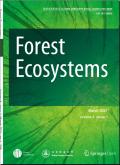确定森林管理的合适区域
IF 3.8
1区 农林科学
Q1 FORESTRY
引用次数: 0
摘要
与偶数年限森林相比,栓皮栎森林(又称不均匀年限森林或连续覆盖森林)可增强森林的复原力和抗干扰能力。它们被认为是减缓气候变化影响的一种适应性选择。在本研究中,我们提出了一种概念方法,用于确定中欧混交林中潜在的适合板块林管理的区域,并将我们的方法应用于奥地利东南部施蒂里亚州的案例研究区域。该概念基于生态和技术经济限制因素,并考虑了预期的未来气候条件及其对板栗林管理的影响。对于每个 1 公顷的森林像素,我们根据银冷杉和至少另外一种耐阴树种的自生态生长条件来评估板栗林管理的生态条件。技术经济约束条件由坡度(≤30%)和到下一条林道的距离(≤100 米)确定,以确保采伐成本效益。结果表明,在目前的气候条件下,施蒂里亚州有 28.1% 或 305,349 公顷的森林可能适合林木管理。2071-2100 年,在 RCP 4.5 气候变化情景下,潜在面积减少到 286,098 公顷(占森林总面积的 26.3%),在 RCP 8.5 情景下减少到 208,421 公顷(占森林总面积的 19.1%)。这些变化的主要原因是低地银冷杉的生长条件不利,而高海拔地区的银冷杉可能会扩大。我们的研究结果可帮助森林管理者确定适合种植银杉的地区,并帮助将偶数年限的纯林转变为不均匀年限的森林,以增强在气候变化下的抵抗力、复原力和生物多样性。本文章由计算机程序翻译,如有差异,请以英文原文为准。
Identifying suitable areas for plenter forest management
Plenter forests, also known as uneven-aged or continuous cover forests enhance forest resilience and resistance against disturbances compared to even-aged forests. They are considered as an adaptation option to mitigate climate change effects. In this study, we present a conceptual approach to determine the potentially suitable area for plenter forest management within central European mixed species forests and apply our approach to the case study area in Styria, the south-eastern Province of Austria. The concept is based on ecological and technical-economic constraints and considers expected future climate conditions and its impact on plenter forest management. For each 1 ha forest pixel, we assess the ecological conditions for plenter forest management according to the autecological growth conditions of silver fir, and at least one additional shade tolerant tree species. The technical-economic constraints are defined by slope (≤30%) and distance to the next forest road (≤100 m) to ensure cost-efficient harvesting. The results show that under current climate conditions 28.1% or 305,349 ha of the forests in Styria are potentially suitable for plenter forest management. For the years 2071–2100 and under the climate change scenario RCP 4.5, the potential area decreases to 286,098 ha (26.3% of the total forest area) and for the scenario RCP 8.5 to 208,421 ha (19.1% of the total forest area). The main reason for these changes is the unfavourable growing conditions for silver fir in the lowlands, while in the higher elevations silver fir is likely to expand. Our results may serve forest managers to identify areas suitable for plenter forests and assist in the transformation of even-aged pure forests to uneven-aged forests to increase resistance, resilience, and biodiversity under climate change.
求助全文
通过发布文献求助,成功后即可免费获取论文全文。
去求助
来源期刊

Forest Ecosystems
Environmental Science-Nature and Landscape Conservation
CiteScore
7.10
自引率
4.90%
发文量
1115
审稿时长
22 days
期刊介绍:
Forest Ecosystems is an open access, peer-reviewed journal publishing scientific communications from any discipline that can provide interesting contributions about the structure and dynamics of "natural" and "domesticated" forest ecosystems, and their services to people. The journal welcomes innovative science as well as application oriented work that will enhance understanding of woody plant communities. Very specific studies are welcome if they are part of a thematic series that provides some holistic perspective that is of general interest.
 求助内容:
求助内容: 应助结果提醒方式:
应助结果提醒方式:


